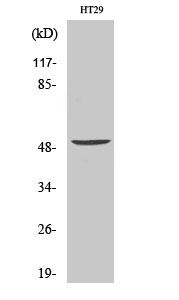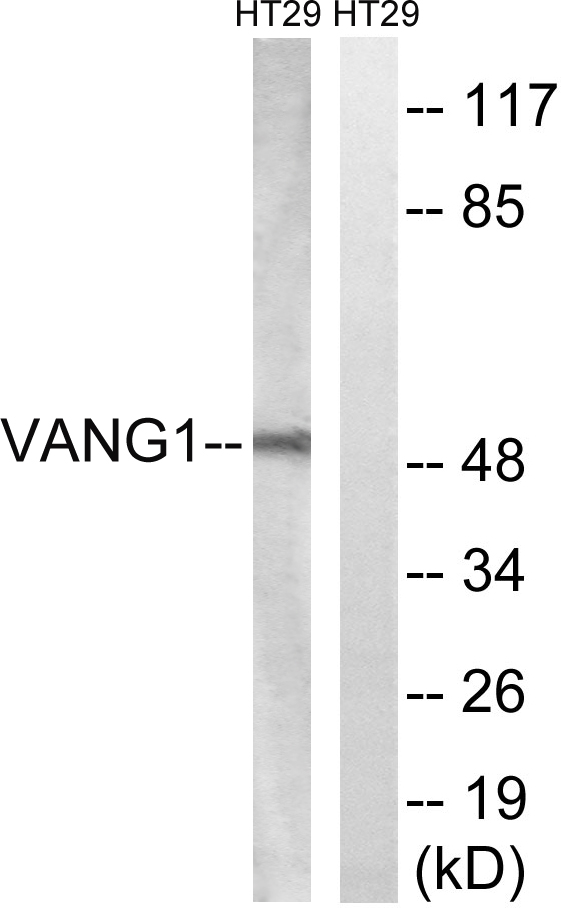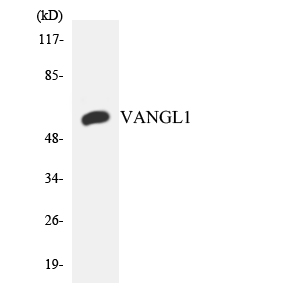Vangl1 Polyclonal Antibody
- Catalog No.:YT4852
- Applications:WB;ELISA
- Reactivity:Human;Mouse
- Target:
- Vangl1
- Fields:
- >>Wnt signaling pathway
- Gene Name:
- VANGL1
- Protein Name:
- Vang-like protein 1
- Human Gene Id:
- 81839
- Human Swiss Prot No:
- Q8TAA9
- Mouse Gene Id:
- 229658
- Mouse Swiss Prot No:
- Q80Z96
- Immunogen:
- The antiserum was produced against synthesized peptide derived from human VANGL1. AA range:301-350
- Specificity:
- Vangl1 Polyclonal Antibody detects endogenous levels of Vangl1 protein.
- Formulation:
- Liquid in PBS containing 50% glycerol, 0.5% BSA and 0.02% sodium azide.
- Source:
- Polyclonal, Rabbit,IgG
- Dilution:
- WB 1:500 - 1:2000. ELISA: 1:20000. Not yet tested in other applications.
- Purification:
- The antibody was affinity-purified from rabbit antiserum by affinity-chromatography using epitope-specific immunogen.
- Concentration:
- 1 mg/ml
- Storage Stability:
- -15°C to -25°C/1 year(Do not lower than -25°C)
- Other Name:
- VANGL1;STB2;Vang-like protein 1;Loop-tail protein 2 homolog;LPP2;Strabismus 2;Van Gogh-like protein 1
- Observed Band(KD):
- 50kD
- Background:
- This gene encodes a member of the tretraspanin family. The encoded protein may be involved in mediating intestinal trefoil factor induced wound healing in the intestinal mucosa. Mutations in this gene are associated with neural tube defects. Alternate splicing results in multiple transcript variants. [provided by RefSeq, Feb 2010],
- Function:
- disease:Defects in VANGL1 are a cause of neural tube defects (NTD) [MIM:182940]. NTD are congenital malformations. The most common forms of NTD are described as open defects (including anencephaly and myelomeningocele, or spina bifida), which result from the failure of fusion in the cranial and spinal region of the neural tube, respectively. Other open dysraphisms (including myeloschisis, hemimyelomeningocele, and hemimyelocele) are sometimes associated with a Chiari type 2 malformation. A number of skin-covered (closed) NTD are categorized clinically depending on the presence of a subcutaneous mass (lipomyeloschisis, lipomyelomeningocele, meningocele, and myelocystocele) or the absence of such a mass (complex dysraphic states, including split cord malformations, dermal sinus, caudal regression, and segmental spinal dysgenesis).,disease:Defects in VANGL1 are a cause of sacral defect with
- Subcellular Location:
- Cell membrane ; Multi-pass membrane protein .
- Expression:
- According to PubMed:11956595, ubiquitously expressed. According to PubMed:12011995, expressed specifically in testis and ovary.
- June 19-2018
- WESTERN IMMUNOBLOTTING PROTOCOL
- June 19-2018
- IMMUNOHISTOCHEMISTRY-PARAFFIN PROTOCOL
- June 19-2018
- IMMUNOFLUORESCENCE PROTOCOL
- September 08-2020
- FLOW-CYTOMEYRT-PROTOCOL
- May 20-2022
- Cell-Based ELISA│解您多样本WB检测之困扰
- July 13-2018
- CELL-BASED-ELISA-PROTOCOL-FOR-ACETYL-PROTEIN
- July 13-2018
- CELL-BASED-ELISA-PROTOCOL-FOR-PHOSPHO-PROTEIN
- July 13-2018
- Antibody-FAQs
- Products Images

- Western Blot analysis of various cells using Vangl1 Polyclonal Antibody. Secondary antibody(catalog#:RS0002) was diluted at 1:20000

- Western blot analysis of lysates from HT-29 cells, using VANGL1 Antibody. The lane on the right is blocked with the synthesized peptide.

- Western blot analysis of the lysates from HeLa cells using VANGL1 antibody.



